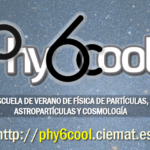Phy6cool: escuela de verano de Física de Partículas, Astropartículas y Cosmología
La cuarta edición de la escuela Phys6cool organizada por Unidad CIEMAT – Física de Partículas se celebrará entre el 26 de junio al 5 de julio de 2024 en formato completamente presencial y tendrá lugar en las instalaciones del CIEMAT (Madrid). Phy6cool está dirigida a estudiantes cursando tercero o cuarto curso del grado de Física (o grados afines) en […]


